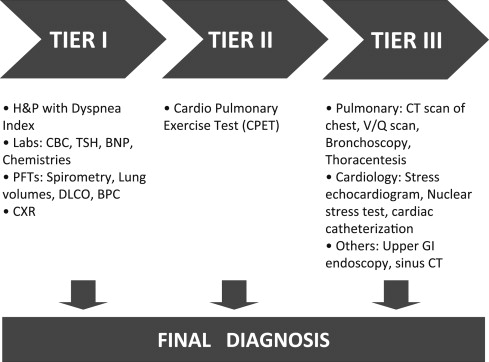An Algorithmic Approach to Chronic Dyspnea
- related: Pulmonology
- tags: #literature #pulmonology
Intro
- PFT: COPD and asthma
- CXR: lung and pleural disorder
- Labs: anemia, thyroid disorder, and heart failure
Protocol

- Move from tier 1 to 2 then to 3 if no clear diagnosis
- Stop at any tier if there’s clear diagnosis
- tier 2 does not include echo
- if CPET points to cardiac: echo or stress echo
- Tier 3: Other organ focused testing includes chest CT, bronchoscopy, echo, nuclear stress, RHC based on previous results.
- Normal Tier 1 and 2 study suggest dyspnea is non-cardiorespiratory, and Tier 3 studies were not necessary1
Links to this note
-
diagnosis of asthma includes typical symptoms and variable airflow limitation
-
obesity related dyspnea has normal VO2 max and reduced VO2 per kg
-
order CPET to diagnose chronic dyspnea and assess preoperative risks
-
difference between asthma, copd, emphysema on PFT
- [^1]: An Algorithmic Approach to Chronic Dyspnea [^3]: Gelb AF, Yamamoto A, Verbeken EK, et al. Unraveling the pathophysiology of the asthma-COPD overlap syndrome: unsuspected mild centrilobular emphysema is responsible for loss of lung elastic recoil in never smokers with asthma with persistent expiratory airflow limitation. Chest. 2015;148(2):313-320.
Footnotes
-
Pratter MR, Abouzgheib W, Akers S, Kass J, Bartter T. An algorithmic approach to chronic dyspnea. Respir Med. 2011 Jul;105(7):1014-21. doi: 10.1016/j.rmed.2010.12.009. Epub 2011 Jan 7. PMID: 21215608. https://pubmed-ncbi-nlm-nih-gov.wake.idm.oclc.org/21215608/ ↩